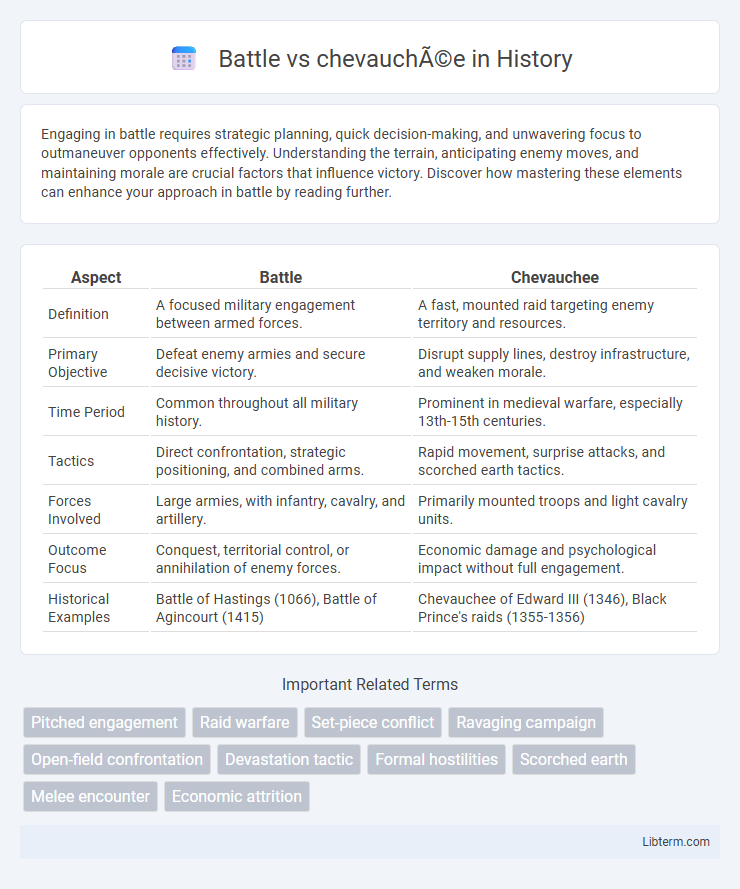Engaging in battle requires strategic planning, quick decision-making, and unwavering focus to outmaneuver opponents effectively. Understanding the terrain, anticipating enemy moves, and maintaining morale are crucial factors that influence victory. Discover how mastering these elements can enhance your approach in battle by reading further.
Table of Comparison
| Aspect | Battle | Chevauchee |
|---|---|---|
| Definition | A focused military engagement between armed forces. | A fast, mounted raid targeting enemy territory and resources. |
| Primary Objective | Defeat enemy armies and secure decisive victory. | Disrupt supply lines, destroy infrastructure, and weaken morale. |
| Time Period | Common throughout all military history. | Prominent in medieval warfare, especially 13th-15th centuries. |
| Tactics | Direct confrontation, strategic positioning, and combined arms. | Rapid movement, surprise attacks, and scorched earth tactics. |
| Forces Involved | Large armies, with infantry, cavalry, and artillery. | Primarily mounted troops and light cavalry units. |
| Outcome Focus | Conquest, territorial control, or annihilation of enemy forces. | Economic damage and psychological impact without full engagement. |
| Historical Examples | Battle of Hastings (1066), Battle of Agincourt (1415) | Chevauchee of Edward III (1346), Black Prince's raids (1355-1356) |
Understanding Medieval Warfare: Battle vs Chevauchée
Medieval warfare tactics varied widely, with battles involving direct, large-scale confrontations between armed forces aiming for decisive victory, while chevauchees emphasized rapid, destructive raids designed to weaken enemy resources and morale without engaging in prolonged combat. Battles required extensive preparation, strategic positioning, and volleys of infantry and cavalry, whereas chevauchees relied on mobility, speed, and surprise to devastate enemy lands and disrupt supply lines. Understanding these distinctions is crucial for comprehending the complexities of medieval military strategy and the varied objectives pursued during conflict.
Defining the Medieval Battle: Tactics and Objectives
Medieval battles were defined by structured tactics aiming to control key terrain, break enemy formations, and achieve decisive victory through direct engagement of heavily armored infantry and cavalry. In contrast, a chevauchee employed fast-moving, raiding cavalry to disrupt enemy logistics, weaken morale, and avoid pitched battle, focusing on economic damage rather than physical conquest. The battle's objective centered on domination and territorial gain, while chevauchee emphasized attrition and psychological warfare.
The Chevauchée Strategy: Raids and Psychological Warfare
The chevauchee strategy involved fast-moving raids deep into enemy territory, aiming to devastate resources, destroy infrastructure, and undermine morale. Instead of direct confrontation, these raids spread fear and chaos, disrupting supply lines and weakening local support for opposing forces. This form of psychological warfare proved effective in eroding the enemy's capacity and will to fight over time.
Key Differences Between Battles and Chevauchées
Battles are structured, large-scale military engagements focused on decisive outcomes through direct confrontation, while chevauchees are rapid, mobile raids aimed at damaging enemy resources and morale. Battles typically involve organized troop formations and strategic positioning, contrasting with the guerrilla-style hit-and-run tactics characteristic of chevauchees. The objective of battles centers on territorial control or annihilation of enemy forces, whereas chevauchees prioritize disruption and economic attrition without necessarily seeking immediate battlefield victory.
Famous Battles in Medieval History
The Battle of Agincourt in 1415 exemplifies a decisive medieval clash where English longbowmen overcame French knights, contrasting with the chevauchee strategy used by Edward III, which aimed to devastate enemy lands through rapid raids rather than direct battles. The Battle of Crecy in 1346 further highlights the effectiveness of disciplined infantry and longbows over mounted knights, marking a shift from chevauchee tactics to more structured engagements. These battles underscore how medieval warfare evolved from widespread raiding methods to strategically planned confrontations that shaped the course of the Hundred Years' War.
Notable Chevauchées: Strategies and Outcomes
Notable chevauchees such as Edward III's 1346 campaign during the Hundred Years' War exemplify rapid cavalry raids aimed at devastating enemy territory to undermine morale and supply lines. These mobile, scorched-earth strategies contrasted with set-piece battles like Crecy, leveraging speed and surprise over direct confrontation to achieve broader strategic goals. Outcomes often included significant economic disruption and psychological impact while forcing opposing armies into disadvantageous engagements.
Impact on Civilian Populations: Battle vs Chevauchée
Battles often resulted in concentrated devastation, causing high civilian casualties and destruction of towns near the conflict zone due to direct military engagement. Chevauchees targeted civilian infrastructure and resources, deliberately undermining the enemy's economic base and morale by widespread pillaging, burning villages, and seizing food supplies. The strategic emphasis of chevauchees on terrorizing and destabilizing rural populations often led to long-lasting famine and displacement, contrasting with the more localized but intense impact of battles.
Political Implications of Both Approaches
Battles often solidify political power by delivering decisive victories that establish clear control over contested territories and legitimize rulers' claims. Chevauchees, through sustained raids and economic disruption, weaken enemy states by undermining their political stability and diminishing civilian support for incumbent leadership. The contrasting approaches influence governance: battles reinforce centralized authority, while chevauchees erode political cohesion and provoke internal dissent within adversary domains.
Military Evolution: From Chevauchées to Pitched Battles
Chevauchees were rapid, destructive raids used in medieval warfare to undermine enemy resources and morale without direct engagement. Over time, military strategy evolved towards pitched battles, emphasizing organized troops, tactical formations, and decisive confrontations to secure territorial control. This shift reflects advancements in army logistics, weaponry, and command structures, marking a significant transformation in medieval combat methodology.
Legacy and Historical Significance
Battles often shaped political boundaries and power dynamics, marking decisive moments that influenced the course of history through strategic military engagements. Chevauchees, characterized by rapid, destructive raids, demonstrated the shift towards psychological warfare and economic disruption in medieval conflicts, influencing future military tactics. Both forms left enduring legacies, with battles embodying direct confrontation legacies and chevauchees highlighting guerrilla-style warfare's impact on civilian populations and medieval economies.
Battle Infographic

 libterm.com
libterm.com